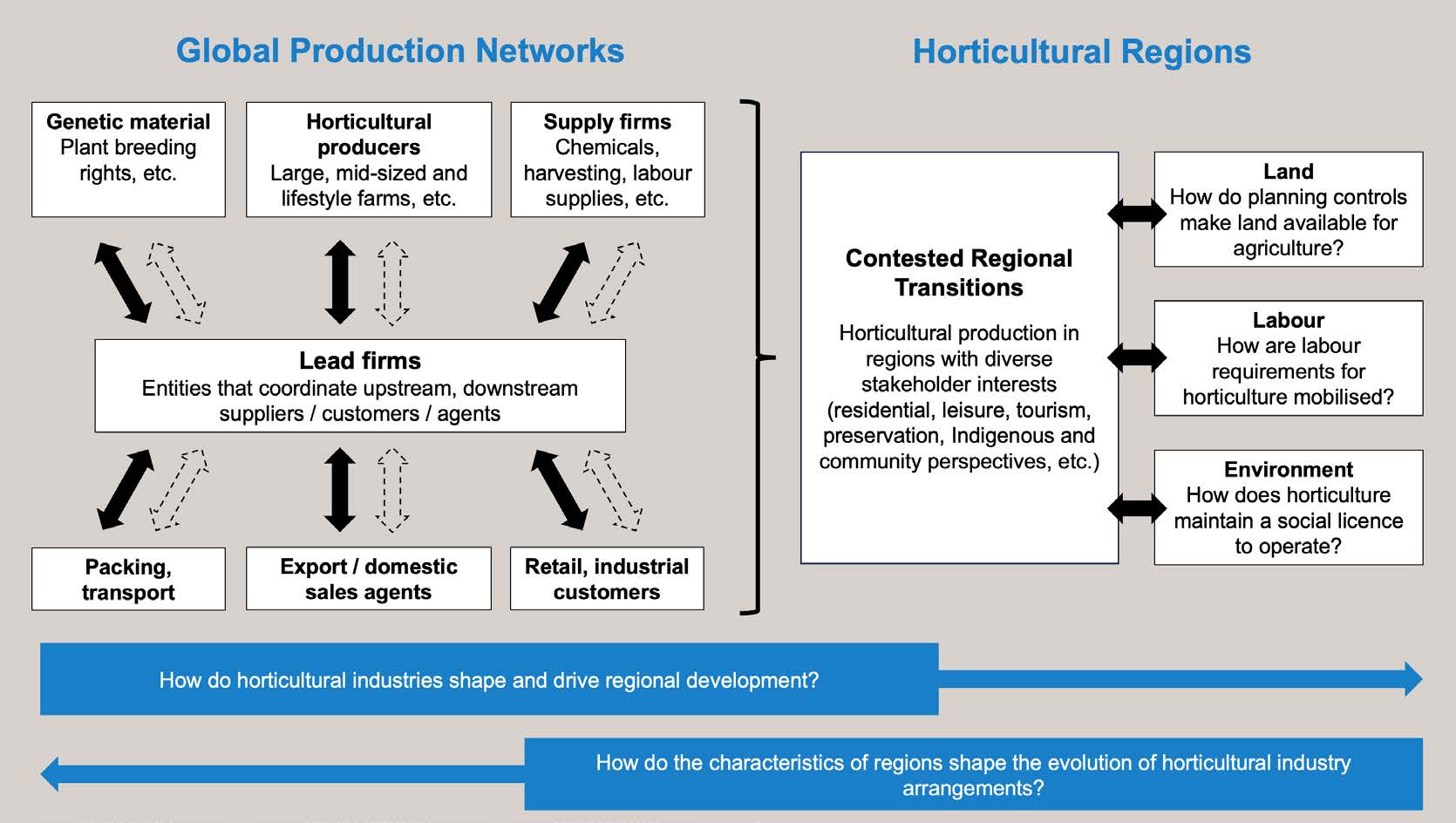Over the past two decades, Australian agriculture has undergone rapid transformation and restructuring, which is particularly evident in the evolution of coastal horticulture. Some areas traditionally used to produce broadacre crops, such as sugarcane, are now being repurposed for horticulture. In other contexts, horticulture has expanded to areas adjacent to residential zones, generating potential for land use conflict. These shifts have elevated the role of horticulture as a regional economic driver but also raised questions about its social license to operate. The fundamental aim of this research project is to understand these tensions, thereby providing industry and community stakeholders with insights that can help generate sustainable outcomes for the industry and host regions.
Central to this goal is an appreciation of the fact that the sector is embedded within global networks, including those providing foreign investment and finance, reliant in many cases on export markets, and highly dependent on overseas workers. This global integration has propelled Australia to become a key player in international horticulture. At the same time, international climate change commitments and increasing global food insecurity underscore the importance of ensuring that horticulture can contribute to thriving communities, sustainable and just food systems, and healthy ecologies into the future.
Our research focuses on horticulture in coastal Queensland and northern New South Wales, where processes of globalisation and industry growth occur within regional landscapes that are multifunctional – that is, where agricultural production occurs alongside a range of other land use values, such as providing a healthy living environment, cultural connection, and ecological value and recreation. The growth of horticulture also places pressure on the labour force and wider community wellbeing, as evolving socio-cultural norms across Australia have further imposed requirements on the horticultural industry to align with sustainable practices. At the same time, lands used for agricultural production are now contested by various interests, such as housing, tourism, Indigenous recognition, and environmental protection. Together, these trends raise critical questions about resource allocation, land use planning, governance, resilience and social justice.
In this dynamic context, this research project delves into the multifaceted changes that have shaped the evolution of horticulture in coastal Australia. It explores the transformation of agricultural activities, the global networks in which the sector is embedded, the competition for land, labour and resources, and the imperative for industry to navigate the evolving social landscape to balance economic priorities with environmental and community considerations.
This three-year research project is funded by the Australian Research Council and includes researchers from three Australian universities. The project seeks to understand the role of globally networked horticulture in processes of regional development.
It examines how issues are being debated and addressed by diverse stakeholders who are located at the ‘global production network-territory nexus’. We use this term to capture the connection between international networks of food production, consumption, retail, trade, investment, lead firms, labour and regulation with the challenges facing multifunctional regions - environmental imperatives, competing land use demands, social-cultural dynamics, and sometimes contrasting visions of regional development (see below).

Figure 1. The GPN-territory nexus as it relates to horticulture in Australia
CPF's research
Our team's work draws out several important social justice issues, including:
Food security and hunger in Australia’s major horticultural production regions – exploring the contradiction of ‘hunger in the food bowl’, wherein residents of major horticultural regions often struggle to access healthy, fresh, and affordable local food. We ask: What are the patterns of food access for people living in horticultural producing regions enmeshed in global production networks? To what extent is regional community food access captured as a value within these networks?
Power dynamics between horticultural growers and major retailers – in light of the recent, ACCC Supermarkets Inquiry, which found that fresh produce growers are particularly vulnerable to exploitative strategies by major supermarkets, focusing on we explore the power asymmetries of supermarket-dominated fresh produce value chains, and the social and environmental implications of these. This is a particularly timely investigation given the recent report of the ACCC Supermarkets Inquiry, which found that fresh produce growers are particularly vulnerable to exploitative pricing and procurement strategies by major supermarkets.
Migrant labour in horticulture – temporary migrant horticulture workers, while fulfiling an important horticultural labour market need, the need for temporary foreign workers in Australian horticulture has facilitated two labour mobility programmes: the Working Holiday Maker scheme (WHM) and the Pacific Australia Labour Mobility scheme (PALM). However, workers in these schemes experience precarity and vulnerability at work and in the community. We investigate what the WHM and PALM temporary labour schemes can tell us about labour regime governance in horticultural global production networks, as sites of contestation and struggle.
Our research has examined these questions through analysis of census, trade, land, industry, and ACCC data, as well as interviews with key stakeholders – including growers, local food distributors and retailers, residents, advocates, local and state government officials. By incorporating the voices and perspectives of local stakeholders, we aim to produce new knowledge that can inform recommendations for a sustainable and equitable future for Australia’s growing horticultural regions.
Associate Professor Jeffrey Neilson, The University of Sydney
Professor William Pritchard, The University of Sydney
Dr Zoe Wang, James Cook University
Dr Rebecca Cross, The University of Sydney
Professor Neil Coe, National University of Singapore
Dr Kiah Smith, The University of Queensland
Dr Rafael Azeredo, Griffith University
Dr Joanna Horton, The University of Queensland

